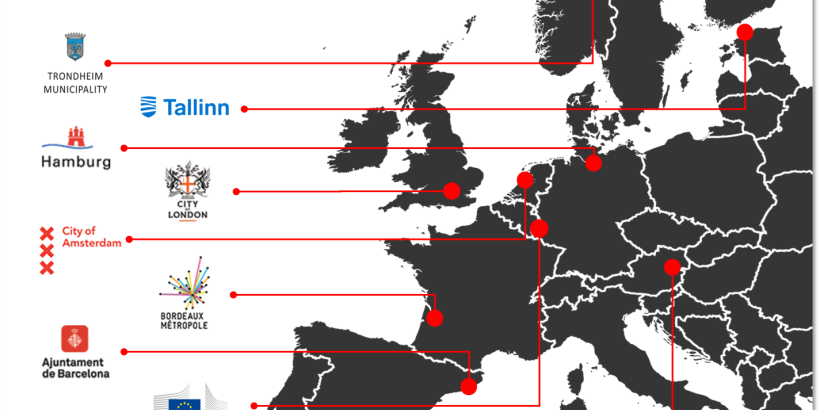
Smart cities and the importance of data interoperability: ten critical success factors.
On 12 and 13 May 2022, the fourth meeting of the CSPF (Cities for Sustainable Public Finances) network took place. This fourth meeting was dedicated to new and disruptive technologies, such as artificial intelligence, its application to smart cities and the role of data in these projects. With the participants of this meeting, a workshop was held on this theme to determine together a top 10 of points of attention that help to increase the chance of success of such projects. A good exchange of data is an important precondition for this. In this article, we explain some initiatives to clarify the importance of data interoperability and also briefly outline the results of the workshop.
Data is everywhere
Data plays an increasingly important role in our lives. It is often called the new “gold” in today’s digitalized society. On the other hand, think of the unsolicited advertisement that you get on your mobile phone because you have recently opened certain websites. Services such as Google, Facebook, Amazon and Instagram know exactly what you are doing and can accurately predict what you may find interesting. Our consumer products are also increasingly data-driven. In the past, you could see under the hood of your car what was wrong in case of a car breakdown. Nowadays, the car mechanic is like an IT specialist since electronics increasingly determine the technology of the car. As a driver, we are also helped by IT with our driving behaviour (think of adaptive cruise control, lane departure control, traffic sign recognition and the smart cars that drive completely independently with some supervision from the driver).
Making an impact with data
As a consequence, data also plays an increasingly important role in our cities, such as smart traffic squares in which sensors regulate the flow of traffic and techniques such as predictive modeling are used. Innovations have not only taken off in our cities because of the initiative from the municipality. More often we see successful public-private partnerships with companies such as Centrics or Google. With all these smart city initiatives, cities hope to tailor their services much better to the needs of citizens, making more impact in the city.
Call for regulation
Promising developments also require regulation, for example from the European Union. This applies to themes such as the prevention of data leaks, security and privacy and the way in which we can exchange data responsibly with each other. The EU Artificial Intelligence Act proposed by the European Commission last year - and now in the process of decision-making - represents a good example and first attempt to horizontally regulate artificial intelligence (AI). It aims to regulate high risk AI and even prohibit AI, which are deemed too risky, while also facilitating investment and innovation in AI. Based on a similar risk-based approach, the EU’s Cybersecurity Strategy aims to strengthen our collective cybersecurity and our response to cyberattacks. It will build a stable and secure global internet where the rule of law, human rights and democratic values are protected. Both legal initiatives are essential elements in securing the indicated interoperability of data - in our case - for the cities.
Making the city smarter with interoperability
Using two practical examples, we clarify the importance of interoperability.
- Garbage truck chips in Amsterdam
In Amsterdam, all garbage trucks are equipped with a chip. This chip weighs the amount of waste collected at each location. The data lends itself to predictive modelling so that waste can be collected smartly, in Amsterdam we call this dynamic waste collection. In practice, we ran into all kinds of start-up problems. The chips did not always work, the model was overcomplicated with all kinds of limiting factors such as not collecting during school hours, avoiding weak bridges and quays and that combined with outdated roadmaps. Because the chip was in the garbage truck and not (also) in the waste containers, it was not clear where the waste exactly came from. As a result, the predictions were incorrect and the routes did not make sense. The initiative in this form did not contribute to a cleaner city. In the meantime, the technique has been further developed and the municipality has learned important lessons from this.
- Urban planning and building permits in Bordeaux
Building permits are typically a city responsibility. Offering an online service to ask for such a permit is compulsory for all cities larger than 3500 inhabitants in France since January 1st, 2022. This digitalization was imposed by a national law at the end of 2018, requiring municipalities to get ready in three years. In the Bordeaux metropolitan area, the IT services are pooled together for 14 municipalities, the building permits instruction is organized in a different pooling system and the final decision remains the remit of 28 different mayors. Building a common IT framework while allowing different policy options was a major challenge (and still remains, as requirements evolve). The key success factors in this project can however be replicated as the metropolis moves forward in building its data strategy
Data is the foundation of such initiatives. If you start with technique, you also end up with technique. The question right at the beginning of a project should already be “what is needed to get a cleaner city”. “How do we make an impact?” Next, a tight business case is needed in which it is important to know the current processes well and to know what impact the new initiative has on all existing processes. Thinking through the initiative right from the beginning will help enormously later in the project. We often see that initiatives are too technically inserted, while the hooking up of the people who have to work with them and the logical integration into the work processes is crucial. Important to approach projects from different perspectives; from the people who have to do the work, the policy makers and from the IT professionals. During all phases of the project (design, implementation and evaluation) alignment of these perspectives is important.
Preconditions for success
Based on these often “shaky” experiences in the application of new technology features, during the fourth meeting of the CSPF, we asked the participants to think about smart city initiatives in their city. Together the group explored the top 10 things that you need to have in mind and arranged to increase the chances of success of such initiatives.
We have come to the following top 10 key success criteria in terms of “voting”:
- Involve employees who know the processes from practice well (and also work there themselves)
- Organizations must be ready, the basis must be at a minimum level and the organizational culture must fit
- Determine tasks, roles and responsibilities and link them to your management information
- Co-creation of relevant stakeholders (internal and external)
- Do good research in advance about the current processes (be aware of what your new process will be)
- Data quality must be at a certain level. Agree well in advance which data quality is needed
- Ensure ownership in the board
- There must be a business case that proves the project’s added value
- A project based on proven technology has different requirements than when customization is central
- Determine what the monitor looks like that should show success
It is striking that many of the recommendations relate to general project management and less specifically to the data itself. Such smart city initiatives affect our work and require a change in approach. Initiatives often come not only from the government but also from the private sector. Ensuring a good alignment of all participants in a project is therefore more complex. It is about coordinating the total business case and that requires coordination between professionals, but also between organizations. The top 10 mainly includes tips in the here and now and in the context of a given project.
Of course, all projects benefit from a globally positive climate, and in general framework measures which increase the chances of successful smart city projects in the future. Among these key success factors are an attention to sovereignty and values in the use of data, and are at the foundation of the GDPR and the recent Digital Services Act. Another key success factor is raising the general level of knowledge in digital matters and in that respect, Estonia offers an interesting and forward-looking example where school-children are introduced to and receive compulsory digital education at an early age in order to create important pre-conditions for technological progress in the future, while at the same time boost a competitive environment.
Inspiring and helpful model from other sectors
In healthcare, the interoperability model used is the so called six-layer model. In the Netherlands, this model comes from the organization Nictiz (www.nictiz.nl). The model has helped healthcare institutions to get digital connection in care chains, in a way that many care files can now be much better tailored to the needs of patients. Because the data is better aligned, healthcare can be organized in a smarter fashion and offered appropriately. This results in better healthcare but also makes healthcare more accessible and less costly. This model could also be used for digital city projects. For patients, residents of a city and for care chains, read the chains of waste collection or applying for permits. The six-layer model essentially means that you can look at a data issue from 6 perspectives and that makes it important to create alignment between all six layers. Not only within your own organization but also between organizations, and not only at one moment in a data project, but during the whole project.

In conclusions, (city) governments must always interrogate themselves as to whether a given innovation represents a genuine value-added. The same applies to smart city initiatives which are generally promising. Facilities in the city will become increasingly data-driven, which, for example- may increase efficiency and the ease with which citizens can interact with local administration, but it also means that more personal data will be stored online.
This offers opportunities for people, but at the same time requires good preparation and attention to possible threats, because of the risk and possible misuse by hackers.
With this article we hope to have contributed to raising awareness on the topic of data interchangeability; what is involved and what we have to take into account. A data-driven future is already here and requires direct attention from all city councils.



